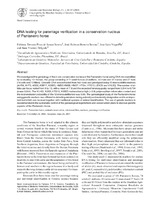DNA testing for parentage verification in a conservation nucleus of Pantaneiro horse
Autor
Sereno, Fabiana Tavares Pires de Souza
Sereno, José Robson Bezerra
Vega-Pla, J.L.
Delgado-Bermejo, J.V.
Editor
Brazilian Society of GeneticsFecha
2008Materia
Pantaneiro horseAnimal conservation
Microsatellites
Markers
Parentage verification
METS:
Mostrar el registro METSPREMIS:
Mostrar el registro PREMISMetadatos
Mostrar el registro completo del ítemResumen
We investigated the genealogy of the in situ conservation nucleus of the Pantaneiro horse using DNA microsatellites
by evaluating 101 horses, the group consisting of 71 adult horses (3 stallions, 40 male and 31 mares) and 27 foals
(14 colts and 13 fillies). Genomic DNA was extracted from hair roots and genotyped using 12 microsatellite markers
(AHT4, AHT5, ASB2, ASB17, ASB23, HMS3 HMS6, HMS7, HTG4, HTG10, LEX33 and VHL20). The number of alleles
per locus varied from 6 to 13, with a mean of 7.8 and the expected heterozygosity ranged from 0.544 to 0.734
(mean 0.644). The VLH20, ASB2, HTG10, ASB23 markers had a high (> 0.8) polymorphism information content and
the total exclusion probability of the 12 microsatellite loci was 0.99. The genealogical study of the Pantaneiro horse
using genetic markers was efficient in detecting mistakes during paternity and maternity designation and is an important
tool which can be used together with traditional systems of animal identification. The use of genetic markers is
recommended in the systematic control of the genealogical registrations and conservation plans to improve genetic
aspects of the Pantaneiro horse

